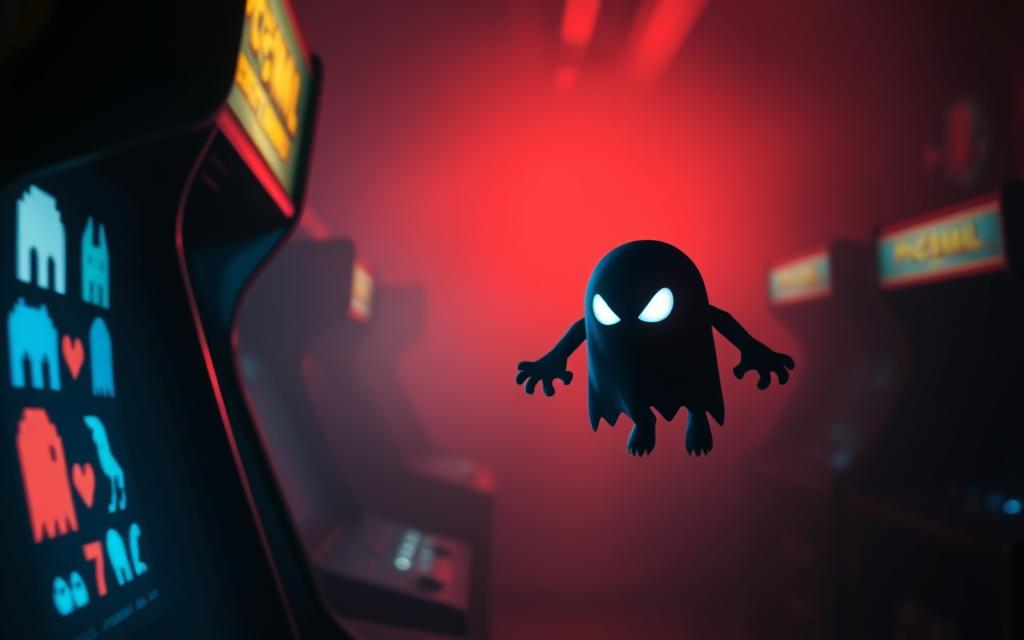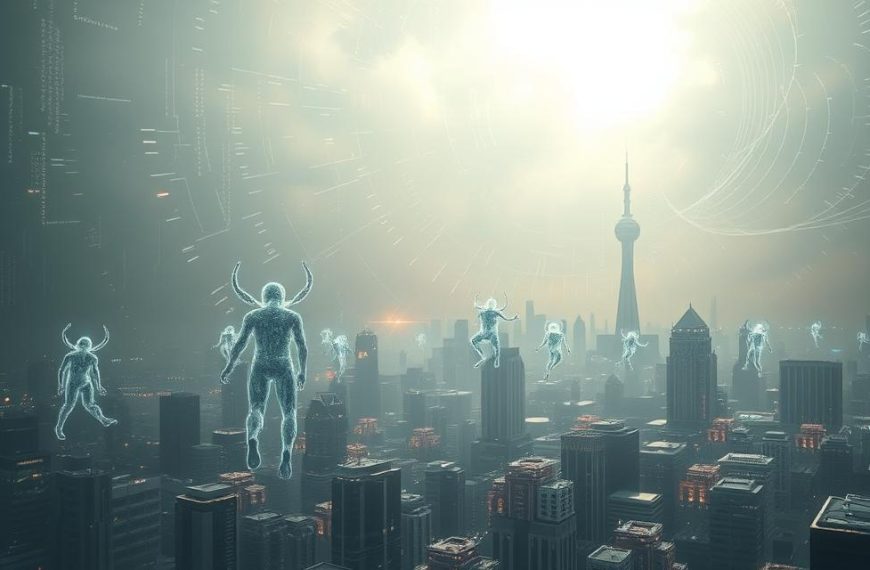The 1980s saw the rise of a maze-chase game that changed the game world. It became a cultural icon. The secret was its revolutionary approach to artificial intelligence. This made its enemies unforgettable.
Designer Toru Iwatani’s team created four unique ghosts with just 2KB of memory. Blinky chased aggressively, Pinky ambushed, Inky moved unpredictably, and Clyde seemed random. Together, they created an uncanny illusion of sentience.
This clever system kept players guessing. Even gaming legend Billy Mitchell couldn’t beat the ghosts. Their dynamic decision-making algorithms changed based on how players played. The team used smart programming, not just power, to create tension.
Today, these ideas shape modern enemy AI. From survival horrors to open-world games, developers look to Pac-Man for inspiration. The ghosts’ lasting appeal shows that great AI comes from understanding people, not just tech.
The Psychology of Pac-Man’s Ghosts
Pac-Man’s ghosts show off clever ghost behaviour patterns for 1980s arcade game AI. Each ghost has its own way of trying to catch Pac-Man, making the game exciting. This design makes players think on their feet, not just follow a pattern.
Four Personalities, One Objective
The ghosts work together but also add chaos to the game. In a 1986 interview, developer Toru Iwatani called them “a team of hunters with different specialisations“. This mix of teamwork and unpredictability changed maze games forever.
| Ghost | Primary Tactic | Targeting Style | Key Feature |
|---|---|---|---|
| Blinky | Direct pursuit | Aggressive | Speed increases with dots eaten |
| Pinky | Ambush | Predictive | Aims 4 tiles ahead |
| Inky | Opportunistic | Unpredictable | Uses Blinky’s position |
| Clyde | Feigned retreat | Erratic | Switches to scatter mode |
Blinky’s Aggressive Pursuit
The red ghost, Blinky, chases Pac-Man directly. It gets faster as Pac-Man eats dots. This makes the game more challenging and fun.
Pinky’s Ambush Tactics
Pink ghost, Pinky, predicts Pac-Man’s path. It aims four tiles ahead, leading to sudden collisions if Pac-Man moves straight.
Inky’s Unpredictable Behaviour
Inky, the cyan ghost, uses both Pac-Man’s and Blinky’s positions. This makes its attacks unpredictable, forcing players to change their plans.
Clyde’s Erratic Patterns
Clyde, the orange ghost, changes between chasing and retreating. When close, it goes into random mode, keeping players on their toes.
Understanding Pac-Man Ghost AI
Pac-Man’s simple look hides complex ghost movement algorithms. These algorithms balance challenge and predictability. They show how target tile calculation and programmed behaviour cycles create the game’s iconic tension.
Target Tile Calculation System
The ghosts’ pursuit strategies use special formulas. These formulas are based on Pac-Man’s position and direction. They update their path 60 times per second.
Blinky’s Direct Chase Formula
Blinky, or ‘Shadow’, targets Pac-Man’s current tile. His algorithm compares coordinates directly. This makes him very aggressive.
- Updates direction at each intersection
- Prioritises shortest path calculations
- Accelerates when fewer dots remain
Pinky’s 4-Tile Offset Strategy
The ‘Speedy’ ghost, Pinky, looks ahead four tiles. This creates ambushes when Pac-Man moves in a certain way.
- Pac-Man moves upward (target shifts 4 tiles up-left)
- Player maintains directional consistency
- Maze walls redirect the calculated path
Global Behaviour Patterns
The ghosts follow group dynamics. These global behaviour patterns make the game more challenging as you progress.
Scatter-Chase Cycle Mechanics
The 7-second scatter phase gives a brief break. Then, there’s a 20-second chase. Don Hodges’ research shows:
“The scatter-chase cycle repeats every 27 seconds until specific pellet thresholds activate permanent chase mode.”
Frightened Mode Limitations
Blue ghosts change direction when hit by a power pellet. But, they have strict rules:
| Level | Frightened Duration | Speed Reduction |
|---|---|---|
| 1-4 | 6 seconds | 50% |
| 5+ | 3 seconds | 70% |
This shows how Pac-Man AI programming keeps the game challenging. It does this while keeping the ghost movement algorithms consistent.
Programming Techniques Behind the Haunting
Creating Pac-Man’s iconic ghost behaviour needed careful balance. It mixed deterministic AI patterns with a bit of randomness. Back in 1980, programmers used only 2KB of ROM to create complex enemy logic. This logic is studied even today.
Deterministic vs Random Elements
The ghosts’ decisions are a mix of rules and randomness. Their target-tile choices follow strict patterns. But, the limited hardware led to creative ways to add some variability.
Ghost House Entry Rules
Ghosts have rules for entering their home. Blue ghost Inky waits for two others to chase Pac-Man before going home. Pinky leaves right after respawning. These rules help players know when to expect the ghosts to return.
Speed Variation Algorithms
Blinky’s “Cruise Elroy” mode kicks in when Pac-Man clears 75% of pellets. His speed then goes up by 5%, making the game more intense. The game uses fixed random seeds for scatter mode, so patterns are always the same.
| Deterministic Elements | Randomised Elements | Control Mechanism |
|---|---|---|
| Target tile selection | Fruit movement paths | Fixed RNG seeds |
| Ghost house access | Scatter mode duration | Pellet counters |
| Direction priorities | Initial spawn delays | Hard-coded tables |
Pathfinding Implementation
The ghost pathfinding logic uses smart algorithms for 1980s hardware. Instead of complex math, designers used shortcuts to make the ghosts seem smart.
Directional Priority Systems
Each ghost has its own turn preferences at intersections. Blinky likes to turn up when far from Pac-Man. Pinky prefers left turns. This keeps the ghosts moving without getting stuck.
Collision Avoidance Protocols
When ghosts are heading towards the same path, they adjust their targets. The code checks for collisions every 8 frames. It changes one ghost’s path by 2 pixels, making their avoidance look natural.
Evolution of Ghost AI Through Arcade History
The journey of Pac-Man’s ghost AI is a captivating tale in gaming history. It shows how AI has grown from simple rules to complex models over 40 years. This change reflects the evolution of arcade game programming.
Original 1980 Implementation
Toru Iwatani’s team created unique ghost personalities with efficient code. Each ghost had its own set of rules:
- Blinky (red) chased Pac-Man directly
- Pinky (pink) ambushed through interception
- Inky (cyan) used unpredictable vector calculations
- Clyde (orange) alternated between pursuit and random movement
The ghosts followed fixed paths, not true paths. Their limited memory (4KB ROM) meant they focused on simple tasks, not complex decisions.
Ms. Pac-Man’s Improved Algorithms
The 1982 sequel, Ms. Pac-Man, brought big changes to the AI. General Computer Corporation added:
- Variable ghost speed settings
- Pattern-based scatter mode timing
- Pseudo-random directional choices in corridors
These updates made the game more exciting. They also made it harder for players to find patterns, unlike in the first game.
Modern Reinterpretations
Games like Pac-Man Championship Edition show how old and new ideas mix. They use:
- Neural network-trained movement prediction
- Dynamic difficulty scaling based on player skill
- Multi-threaded AI processing
Even with these new features, the ghosts’ original traits are kept. This blend of old and new keeps the game exciting for all players.
Player Strategies Against AI Patterns
Mastering Pac-Man is not just about quick reflexes. It’s about understanding how to use the game’s ghost patterns to your advantage. Experienced players use smart tactics to turn the AI’s patterns into chances for high scores.
Luring Techniques
Skilled players use Blinky’s aggressive nature to their benefit. When Pac-Man collects dots, Blinky speeds up. This allows players to create safe paths by timing their movements perfectly.
Using Blinky as Pacemaker
By keeping Blinky behind Pac-Man, players create a safe zone. World record holder Billy Mitchell showed how to do this in his maze navigation tactics guide. The trick is to keep the right distance by controlling Pac-Man’s speed.
Predicting Pinky’s Trajectory
Pinky’s ambushes are tricky, but her patterns are predictable. Players can force miscalculations by suddenly changing direction near walls. This exploits Pinky’s limited pathfinding in tight spots.
Pattern Memorisation
Top players know the AI’s cycle and manage pellets well. They understand when to dodge or attack based on the game’s 21-phase ghost mode rotation.
Safe Zone Identification
Places like the central tunnel and lower-left corner are safe. They limit attack angles and let players track threats. To use these spots effectively, players need to:
- Watch for ghost colour changes
- Count movement cycles
- Time power pellet use
Power Pellet Timing
Using power pellets to eat ghosts in the first 5 seconds gives the most points. Experts activate pellets when:
- Multiple ghosts gather near junctions
- Blinky is in his “Cruise Elroy” phase
- The AI cycle resets to scatter mode
This AI exploitation strategy turns defensive items into scoring tools. It’s key for reaching high scores.
Legacy of Pac-Man’s Enemy AI
Four decades after its release, Pac-Man’s ghost AI is a top example in game design. It mixes simple patterns with complex behaviour. This mix has influenced both games and academic studies.
From university classes to competitive gaming, Pac-Man’s 1980s charm is timeless. It shows the technical depth of its design.
Influence on Subsequent Game Design
The game AI influence of Pac-Man’s ghosts is seen in games like Among Us and Dead by Daylight. These games use the ghosts’ predictable yet flexible logic. Designers often look to Pac-Man for inspiration.
They adopt innovations such as:
- Character-specific pathfinding priorities
- State-based behaviour switching
- Player-position prediction algorithms
Academic Interest in Game AI
Stanford University studied Pac-Man’s ghost AI in 2016. They looked at how it efficiently navigates paths. The Smithsonian also recognised the Pac-Man Dossier as a key document.
Researchers are fascinated by how the 8-bit system achieved complex AI. It did so with:
- Limited computational resources
- Elegant target tile calculations
- Deterministic decision trees
Speedrunning Community Exploits
World-record holders in Pac-Man use Pac-Man speedrun tactics to win by tiny margins. They aim for “scatter mode” to control ghosts. This skill was showcased at the 2019 Classic Tetris World Championship.
The Enduring Genius of Pac-Man’s Haunting Algorithms
Pac-Man’s ghost behaviour shows how 1980s tech created lasting gameplay. Toru Iwatani’s team at Namco focused on making the game engaging, not just fast. They gave each ghost its own way of moving, making the game more interesting.
This approach made Blinky aggressive and Pinky sneaky. These tactics create challenges that players can’t fully predict. This mix of rules and surprise keeps the game exciting.
Games like Among Us and Five Nights at Freddy’s follow this pattern. They use a mix of patterns and surprises to keep players engaged. Even today, Pac-Man’s AI is studied at places like MIT and Stanford.
Forty years after it first came out, Pac-Man is a lesson in making games deep but easy to play. In a 2015 GDC interview, Iwatani said: “True longevity comes from systems that reveal new layers, not just higher speeds.” This idea shows why Pac-Man is loved by both casual players and esports pros.


















